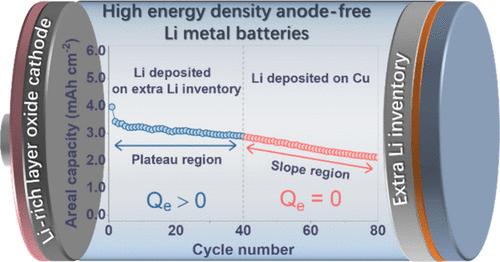富锂层状氧化物正极材料对无阳极锂金属电池多余锂储量的调节
IF 9.1
1区 材料科学
Q1 CHEMISTRY, MULTIDISCIPLINARY
引用次数: 0
摘要
无阳极锂金属电池利用富锂层状氧化物(LRO)正极材料提供额外的锂库存,以补偿循环过程中持续的锂损耗。通过探索可逆/不可逆锂消耗行为,阐明了 LRO 在无阳极系统中的锂补偿机制。此外,还定量分析了 Cu||LRO 电池的阴极等容量、锂存量和循环性能之间的关系。精心设计的无阳极 Cu||LRO 电池在 5.0 mAh cm-2 的实际等容量条件下循环 60 次后的容量保持率为 51%,超过了 Cu||NCM523 0.6% 的容量保持率。进一步优化人工阳极保护层和全氟化电解质后,Cu||LRO 的容量保持率在 60 个循环后分别提高到 61.4% 和 71.5%。结合其低初始库仑效率和高比能量,LRO 阴极在未来高能量、长寿命无阳极锂金属电池的开发中展现出了广阔的前景。本文章由计算机程序翻译,如有差异,请以英文原文为准。

Regulation of Extra Li Inventory in Anode-Free Lithium Metal Batteries by Li-Rich Layered Oxide Cathode Materials
Li-rich layered oxide (LRO) cathode material is utilized in anode-free Li metal batteries to provide extra Li inventory, compensating for the constant Li loss during cycling. The Li compensation mechanism of LRO in the anode-free system is elucidated by exploring the reversible/irreversible Li consumption behaviors. Moreover, the relationship between cathode areal capacity, Li inventory, and the cycling performance of the Cu||LRO cell is quantitatively analyzed. The well-designed Cu||LRO anode-free cell demonstrates 51% capacity retention after 60 cycles at a practical areal capacity of 5.0 mAh cm–2, overwhelming the 0.6% capacity retention for Cu||NCM523. Further optimization with an artificial anode protection layer and a fully fluorinated electrolyte enhances the capacity retention of Cu||LRO to 61.4% and 71.5% after 60 cycles, respectively. Combining its low initial Coulombic efficiency and high specific energy, the LRO cathode shows great prospects in the future development of high energy and long lifespan anode-free Li metal batteries.
求助全文
通过发布文献求助,成功后即可免费获取论文全文。
去求助
来源期刊

Nano Letters
工程技术-材料科学:综合
CiteScore
16.80
自引率
2.80%
发文量
1182
审稿时长
1.4 months
期刊介绍:
Nano Letters serves as a dynamic platform for promptly disseminating original results in fundamental, applied, and emerging research across all facets of nanoscience and nanotechnology. A pivotal criterion for inclusion within Nano Letters is the convergence of at least two different areas or disciplines, ensuring a rich interdisciplinary scope. The journal is dedicated to fostering exploration in diverse areas, including:
- Experimental and theoretical findings on physical, chemical, and biological phenomena at the nanoscale
- Synthesis, characterization, and processing of organic, inorganic, polymer, and hybrid nanomaterials through physical, chemical, and biological methodologies
- Modeling and simulation of synthetic, assembly, and interaction processes
- Realization of integrated nanostructures and nano-engineered devices exhibiting advanced performance
- Applications of nanoscale materials in living and environmental systems
Nano Letters is committed to advancing and showcasing groundbreaking research that intersects various domains, fostering innovation and collaboration in the ever-evolving field of nanoscience and nanotechnology.
 求助内容:
求助内容: 应助结果提醒方式:
应助结果提醒方式:


